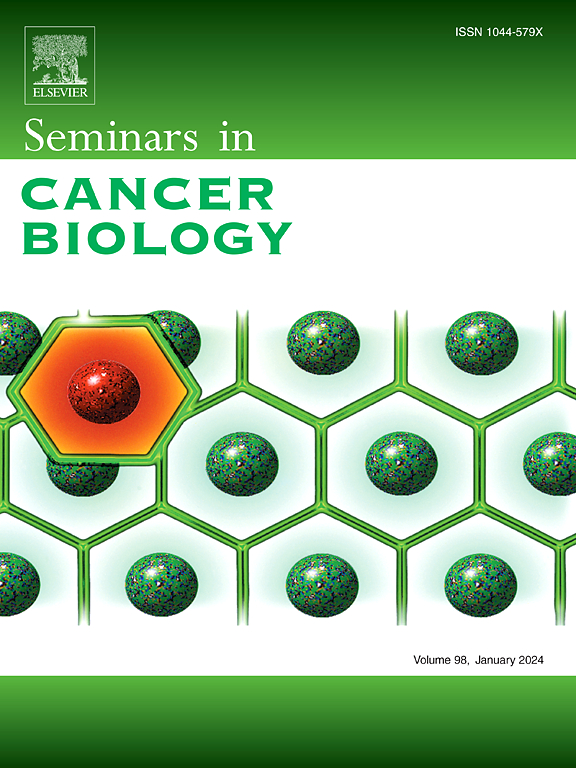类器官、组织切片和器官型培养:通过体外和离体模型提高我们对胰腺导管腺癌的理解。
IF 12.1
1区 医学
Q1 ONCOLOGY
引用次数: 0
摘要
胰腺导管腺癌(PDAC)是所有常见实体癌中预后最差的一种。对于绝大多数PDAC患者,仅适用疗效非常有限的全身治疗。此外,免疫疗法并没有带来其他癌症类型的进展。PDAC的几个关键特征导致治疗结果不佳,在这篇综述中,我们将讨论如何在目前可用的离体或体外模型系统中最好地捕获这些特征。例如,PDAC的特点是高度结缔组织增生和免疫抑制的肿瘤微环境,影响疾病进展和治疗耐药性。此外,肿瘤之间和肿瘤内部存在巨大的肿瘤生物学差异,使治疗决策复杂化。此外,PDAC具有非常高的局部侵袭性和转移性生长倾向。动物模型的使用通常是不可取或不可行的,并且已经开发了几种体外和离体模型系统,例如器官型共培养和组织切片等。然而,缺乏完整的宿主生物会影响这些模型准确捕捉导致PDAC预后不良的特征的能力。我们将在PDAC的关键特征的背景下讨论这些模型系统的注意事项和优点,并提供关于模型选择和优化可能性的建议。这些考虑应该对旨在在体外环境中研究PDAC的研究人员有用。本文章由计算机程序翻译,如有差异,请以英文原文为准。
Organoids, tissue slices and organotypic cultures: Advancing our understanding of pancreatic ductal adenocarcinoma through in vitro and ex vivo models
Pancreatic ductal adenocarcinoma (PDAC) has one of the worst prognoses of all common solid cancers. For the large majority of PDAC patients, only systemic therapies with very limited efficacy are indicated. In addition, immunotherapies have not brought the advances seen in other cancer types. Several key characteristics of PDAC contribute to poor treatment outcomes, and in this review, we will discuss how these characteristics are best captured in currently available ex vivo or in vitro model systems. For instance, PDAC is hallmarked by a highly desmoplastic and immune-suppressed tumor microenvironment that impacts disease progression and therapy resistance. Also, large differences in tumor biology exist between and within tumors, complicating treatment decisions. Furthermore, PDAC has a very high propensity for locally invasive and metastatic growth. The use of animal models is often not desirable or feasible and several in vitro and ex vivo model systems have been developed, such as organotypic cocultures and tissue slices, among others. However, the absence of a full host organism impacts the ability of these models to accurately capture the characteristics that contribute to poor outcomes in PDAC. We will discuss the caveats and advantages of these model systems in the context of PDAC’s key characteristics and provide recommendations on model choice and the possibilities for optimization. These considerations should be of use to researchers aiming to study PDAC in the in vitro setting.
求助全文
通过发布文献求助,成功后即可免费获取论文全文。
去求助
来源期刊

Seminars in cancer biology
医学-肿瘤学
CiteScore
26.80
自引率
4.10%
发文量
347
审稿时长
15.1 weeks
期刊介绍:
Seminars in Cancer Biology (YSCBI) is a specialized review journal that focuses on the field of molecular oncology. Its primary objective is to keep scientists up-to-date with the latest developments in this field.
The journal adopts a thematic approach, dedicating each issue to an important topic of interest to cancer biologists. These topics cover a range of research areas, including the underlying genetic and molecular causes of cellular transformation and cancer, as well as the molecular basis of potential therapies.
To ensure the highest quality and expertise, every issue is supervised by a guest editor or editors who are internationally recognized experts in the respective field. Each issue features approximately eight to twelve authoritative invited reviews that cover various aspects of the chosen subject area.
The ultimate goal of each issue of YSCBI is to offer a cohesive, easily comprehensible, and engaging overview of the selected topic. The journal strives to provide scientists with a coordinated and lively examination of the latest developments in the field of molecular oncology.
 求助内容:
求助内容: 应助结果提醒方式:
应助结果提醒方式:


